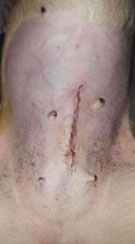Laparoscopic neutering, also known as ‘keyhole surgery’, provides an alternative means of performing various abdominal surgeries. It is widely recognised as the ‘gold standard’ surgical approach in human patients, and has since become an exciting new development in the veterinary world.
Keyhole neutering is performed by a veterinary surgeon that has underwent extensive laparoscopic training, and involves the use of specialist laparoscopic equipment.
The most common type of laparoscopic surgery performed in veterinary practice is laparoscopic neutering, more specifically a laparoscopic ovariectomy.
We offer lap spays as a Fixed Price Procedure at £650.
What is a laparoscopic spay?
A laparoscopic spay, more formally referred to as laparoscopic ovariectomy, is the removal both ovaries from a female dog. More traditionally, both the ovaries along with the uterus (i.e. the womb) would be removed, however numerous veterinary studies have since demonstrated that in order to successfully neuter a female dog, only removing both ovaries is necessary.
What does a laparoscopic spay involve?
As with any abdominal surgery, a laparoscopic spay is performed under general anaesthetic. Under controlled conditions, the abdomen is safely inflated with carbon dioxide gas, and a camera is used to locate each ovary on either side of the abdomen. Specialist equipment is then used to grasp and remove the ovary from the abdomen. Once complete, each small incision made is closed in 3 layers, and all stitches are buried under the skin and will dissolve on their own.
Why choose a laparoscopic spay over a traditional spay?
Laparoscopic surgery is much less invasive when compared to more traditional means of abdominal surgery. The more traditional approach requires a long incision along the abdomen (5-10cm) (figure 1). The laparoscopic approach leaves only two-three 0.5cm wounds (figure 2 ). As a result, this significantly reduces patient post-operative pain and discomfort.
 Figure 1
Figure 1  Figure 2
Figure 2
Additional benefits of laparoscopic surgery include:
- smaller surgical wounds
- faster recovery time post-operatively
- reduced pain post-operatively
- reduced risk of perioperative bleeding
- reduced risk of wound infection
- improved visualisation of abdominal anatomy
- reduced surgical time.
What other laparoscopic surgeries are available?
Laparoscopic surgery can also be used in place of a number of abdominal surgical procedures, and thus reduces the need to perform more invasive procedures, for example:
- cryptorchid castration (i.e. removal of one or both retained testicles in a male dog)
- abdominal organ biopsy
- elective gastropexy in ‘at risk’ dog breeds (i.e. fixing the stomach to the inside of the abdominal wall)
Referral Form
This form is for Veterinary Professionals to refer patients to us. If you are a pet owner please speak to your General Practice Vet about being referred to The Roundhouse Veterinary Hospital.
Please don’t use this form in the case of an emergency. Please contact us here for emergencies.

How can I find out more information on laparoscopic neutering?
If you are interested in booking your pet in for a laparoscopic neuter, or would like to discuss this further with a member of our veterinary team, please do not hesitate to contact the Roundhouse Veterinary Hospital on 0141 649 4949.










